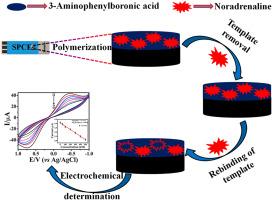使用分子印迹聚(3-氨基苯硼酸)测定去甲肾上腺素的理论筛选和电化学传感器。
IF 2.6
4区 生物学
Q2 BIOCHEMICAL RESEARCH METHODS
引用次数: 0
摘要
去甲肾上腺素(NE)是医学领域关注的主要儿茶酚胺(CA),因为它在调节荷尔蒙和神经系统方面发挥着关键作用。某些 NE 浓度失调会导致一些严重的身体状况。因此,快速灵敏地检测 NE 在医疗技术中至关重要。因此,在这项研究中,使用分子印迹聚合物(MIP)创建了一种选择性检测 NE 的电化学传感器。在此之前,利用分子力学和量子力学计算,通过分子建模选择了功能单体。根据这些研究,在分子建模计算中,3-氨基苯硼酸(3-APBA)功能单体与 NE 产生的复合物最为稳定。在此基础上,通过在模板分子 NE 存在下对 3-APBA 进行电聚合,在丝网印刷碳电极(SPCE)表面形成压印聚合物薄膜。研究人员通过差分脉冲伏安法(DPV)、循环伏安法(CV)、扫描电子显微镜(SEM)和电化学阻抗谱(EIS)对印迹聚合物薄膜的逐步制备过程进行了检验。研究并优化了电化学 NE 传感器的去除性能和模板的再结合水平。通过对多巴胺、酪氨酸和血清素等小分子的干扰研究,证实了 NE 的选择性。在最佳水平下,所制造的 MIP 传感器在 0.1 pM 至 5 pM 的 NE 浓度范围内具有较宽的线性范围;灵敏度:0.004 mA pM-1;检测限:0.03 pM:0.03 pM。值得注意的是,新制作的 MIP 传感器在检测血浆样品中的 NE 方面得到了有效验证。本文章由计算机程序翻译,如有差异,请以英文原文为准。

Theoretical screening and electrochemical sensor for determination of norepinephrine using a molecularly imprinted poly (3-amiophenylboronic acid)
Norepinephrine (NE) is the primary catecholamine (CA) of interest in the medical field, as it plays a key role in regulating the hormonal and neurological systems. Some NE concentration dysfunction can lead to a number of serious physical conditions. As a result, quick and sensitive NE detection is most critical in medical technology. Thus, in this research, a molecularly imprinted polymer (MIP) was used to create an electrochemical sensor for the selective detection of NE. Prior to this, functional monomers were chosen through molecular modeling utilizing molecular mechanics and quantum mechanics computations. According to these studies, the 3-aminophenylboronic acid (3-APBA) functional monomer produces the most stable complex with NE in molecular modeling calculations. Based on this, by electropolymerizing 3-APBA in the presence of the template molecule NE, an imprinting polymer film is formed on the screen-printed carbon electrode (SPCE) surface. Stepwise fabrication of imprinted polymer films was examined through differential pulse voltammetry (DPV), cyclic voltammetry (CV), scanning electron microscopy (SEM), and electrochemical impedance spectroscopy (EIS). The performance of the electrochemical NE sensor removal and rebinding levels of the template was studied and optimized. The selectivity for NE was confirmed by using interference studies of small molecules like dopamine, tyrosine, and serotonin. Under optimum levels, the fabricated MIP sensor had a broad linear range over NE concentrations of 0.1 pM–5 pM; sensitivity: 0.004 mA pM−1; limit of detection: 0.03 pM. It is noteworthy that the newly created MIP sensor was effectively validated for NE detection in plasma samples.
求助全文
通过发布文献求助,成功后即可免费获取论文全文。
去求助
来源期刊

Analytical biochemistry
生物-分析化学
CiteScore
5.70
自引率
0.00%
发文量
283
审稿时长
44 days
期刊介绍:
The journal''s title Analytical Biochemistry: Methods in the Biological Sciences declares its broad scope: methods for the basic biological sciences that include biochemistry, molecular genetics, cell biology, proteomics, immunology, bioinformatics and wherever the frontiers of research take the field.
The emphasis is on methods from the strictly analytical to the more preparative that would include novel approaches to protein purification as well as improvements in cell and organ culture. The actual techniques are equally inclusive ranging from aptamers to zymology.
The journal has been particularly active in:
-Analytical techniques for biological molecules-
Aptamer selection and utilization-
Biosensors-
Chromatography-
Cloning, sequencing and mutagenesis-
Electrochemical methods-
Electrophoresis-
Enzyme characterization methods-
Immunological approaches-
Mass spectrometry of proteins and nucleic acids-
Metabolomics-
Nano level techniques-
Optical spectroscopy in all its forms.
The journal is reluctant to include most drug and strictly clinical studies as there are more suitable publication platforms for these types of papers.
 求助内容:
求助内容: 应助结果提醒方式:
应助结果提醒方式:


